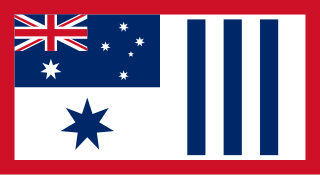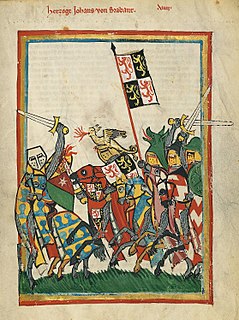 W
WThe Australian Defence Force Ensign is a flag of Australia which represents the tri-service Australian Defence Force. The design was formally recognised by the Australian Government as a flag of Australia with an amendment to the Flags Act 1953 passed on 14 April 2000.
 W
WThe Australian Honour Flag is a special Australian flag that was created by the Commonwealth Government in 1918, as a result of World War I. It consists of a white flag, with the national flag in canton, a large 7-pointed star, and three blue vertical bars, with a red border overall.
 W
WBaucent was the name of the war flag used by the Knights Templar in the 12th and 13th centuries. 13th-century sources show it as a white gonfanon with a black chief . Jacques de Vitry, writing in the 1220s, mentions the gonfanon baucent and explains that the black and white colours symbolise the Templar's ferocity towards their enemies and their kindness towards their friends. It appears that later in the 13th century, the red cross of the Templar could be added to the banner. In a damaged fresco of the late 13th century in the Templar church of San Bevignate, Perugia, a Templar banner is depicted with the upper half in white and the lower half in black, with the red cross patty attached to the white field. The same fresco also shows a shield and horse-covers in the same design.
 W
WThe flag of the Chinese People's Liberation Army is the war flag of the People's Liberation Army; the layout of the flag has a golden star at the top left corner and two Chinese characters "八一" to the right of the star, placed on a red field. The characters "八一" are a reference to the events of August 1, 1927 ; when the PLA was created by the Communist Party of China at the start of their rebellion in Nanchang against the Kuomintang Government.
 W
WThe Western Union (WU) was a military alliance established between France, the United Kingdom and the three Benelux countries between 1948 and 1954. The flag of the Western Union, also referred to as the Western Union Standard, displays an unbroken chain of five rectangular links Or in the shape of an upside-down pentagon on a blue field, with a multicoloured border taken from the WU member states' flags.
 W
WThe several branches of the Armed Forces of the Islamic Republic of Iran are represented by flags. Within the Iranian military, various flags fly on various occasions, and on various ships, bases, camps, and military academies.
 W
WFlags of the Republic of Vietnam Military Forces. Most of the flags used by the South Vietnam military since 1955 to 1975.
 W
WFlags of the Royal Thai Armed Forces. Most of the flags used by the Thai military today were stipulated in the Flag Act of 1979.
 W
WThe contemporary display of the Confederate battle flag began as a response to the civil rights movement of the 1950s and 1960s and has been seen used to this day in some instances in support of white nationalist and white supremacist movements, some of which commemorate the defunct Confederate States of America. The revival of the Confederate battle flag, together with other Confederate flags, began with Senator Strom Thurmond's Dixiecrats in reaction to growing public support for racial equality, alongside opposition to civil rights in 1948. Although never an official national flag, the most popular and widely recognized symbol of the Confederacy is a rejected national design that was used as a battle flag.
 W
WThe term Reichskriegsflagge refers to several war flags and war ensigns used by the German armed forces in history. A total of eight different designs were used in 1848/49 and between 1867/1871 and 1945.
 W
WThe royal standards of England were narrow, tapering swallow-tailed heraldic flags, of considerable length, used mainly for mustering troops in battle, in pageants and at funerals, by the monarchs of England. In high favour during the Tudor period, the Royal English Standard was a flag that was of a separate design and purpose to the Royal Banner. It featured St George's Cross at its head, followed by a number of heraldic devices, a supporter, badges or crests, with a motto—but it did not bear a coat of arms. The Royal Standard changed its composition frequently from reign to reign, but retained the motto Dieu et mon droit, meaning God and my right; which was divided into two bands: Dieu et mon and Droyt.
 W
WThe South African Defence Force Ensign was the flag used by the South African Defence Force (SADF) as a unified flag for all of the South African Defence Forces after they had previously only used their own individual flags. It consisted of a green ensign with the flag of South Africa in canton with a crest consisting of three symbols of the SADF forces inside an outline of the Castle of Good Hope. The flag was adopted in 1981 but was replaced in 1994 following the adoption of a new flag and the reorganization of the armed forces in South Africa as the South African National Defence Force but was still used for a few months after.
 W
WThe Tibetan flag, also known as the "snow lion flag", was the flag of the de facto independent polity of Tibet from 1916 to 1951. It was adopted by the 13th Dalai Lama in 1916. Banned by the Chinese government since 1959, the flag has not been in official use by any region in the world since 1951; however it is used by the Tibetan Government in Exile, based in Dharamshala, India.
 W
WA war flag, also known as a military flag, battle flag, or standard, is a variant of a national flag for use by a country's military forces when on land. The nautical equivalent is a naval ensign. Under the strictest sense of the term, few countries today currently have proper war flags, most preferring to use instead their state flag or standard national flag for this purpose.
 W
W W
W W
W W
W